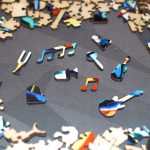
Okay, I know my Stack Overflow is generally a books column, but today I’m making an exception—it’s all about puzzles! (Several of these have been sent to me by book publishers, so that counts, right?) But don’t worry, I’ll have more books for you soon.
My family and I—especially me—have been working on a lot of puzzles lately. Since I’m usually assembling these on my game table, I have a limited amount of time to complete a puzzle between my (usually) weekly game nights, so that’s been a challenge for some of the harder puzzles. My youngest daughter loves sorting out pieces, whether that’s looking for the edge pieces at the beginning or finding a specific color or pattern. Several of us have found that it’s really hard to walk away from an incomplete puzzle, too—you think “oh, I’m just going to find this one next piece” and the next thing you know you’ve been at it for an hour. I’ve done some puzzles while watching a show, and I’ve done some late at night after everyone’s gone to bed and the house is quiet.
Here’s a look at several of the puzzles we’ve tried in the past couple months.

LEGO Mystery Minifigure Mini Puzzle
($8.95, Chronicle Books, 126 pieces)
Chronicle Books has several different LEGO puzzles (some of which I’ve shared about before), and I’ve put together two more. The first is a tiny puzzle, 126 pieces that make a 6″x9″ picture when completed. It’s a LEGO minifigure, and just like the actual mystery packs, when you buy the puzzle you don’t know which one you’ll get inside. There are four known possibilities—hot dog, unicorn, shark, and flower—and two mystery options. We got the shark—the biggest challenge assembling this one was that the background and the figure are both shades of blue, so it could be a little tricky figuring out, but the puzzle itself is only so big. The pieces in this one are slightly smaller than a typical jigsaw puzzle, but not by much.
I’m curious whether all of the minifigure puzzles use the same die for cutting, because if so, then you could do some fun puzzle mashups.

LEGO Space Stars Puzzle
($17.95, Chronicle Books, 1000 pieces)
I was particularly excited about this one, because I grew up playing with the space sets, so I had a lot of astronaut minifigs, as well as some spaceships in that iconic grey-blue-yellow color palette. Like the paint pots puzzle, this one lent itself to completing by color group. Other than the yellow, which is the same color as all the faces, it was pretty easy to find most of the pieces of one color, so I was able to work on this one figure at a time. I was able to separate out the two spaceships by the angle and size of the LEGO studs, but the starfield was the big challenge because there was so much of it that was similar.
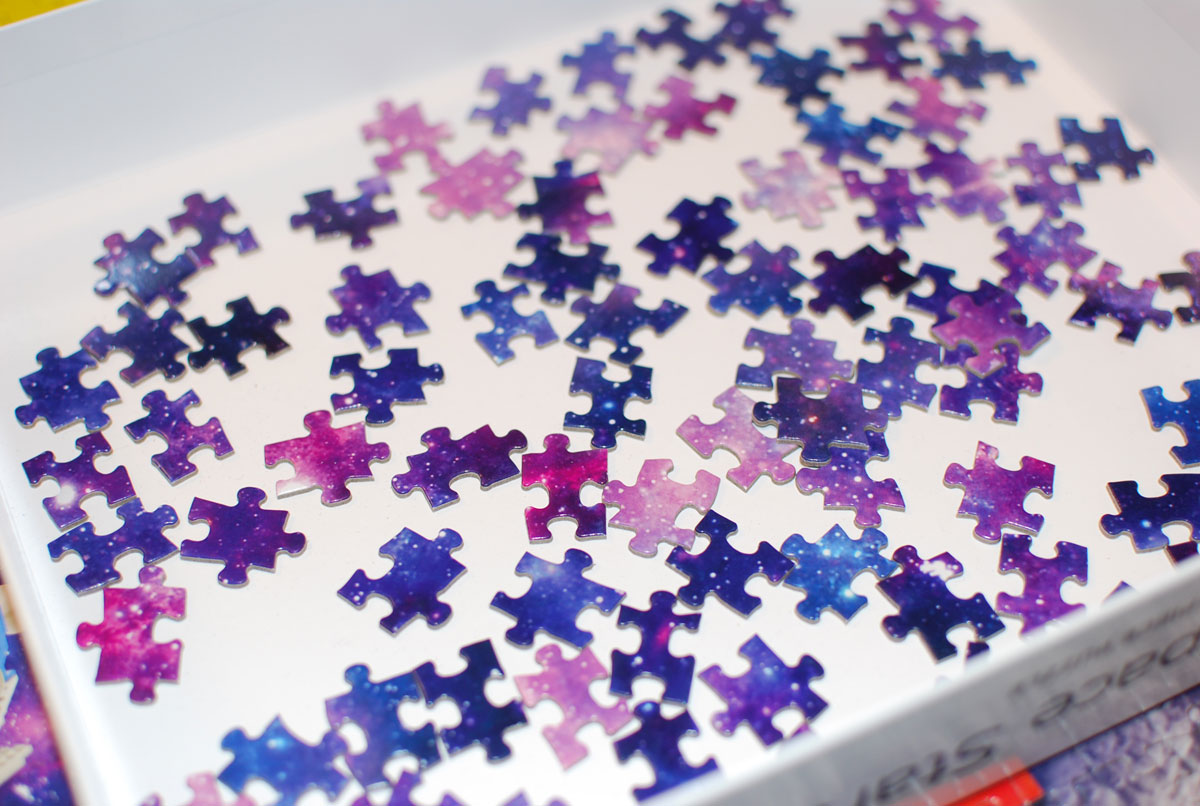
We like to try to do puzzles without referring to the box cover for the added challenge, so the red and blue astronauts had me stumped at first because they’re turned to the side. This puzzle does include a small poster of the image as a reference, though, which is handy if you use the box bottom and lid to sort pieces.

One other nice feature is that the pieces for this one came in a recyclable paper envelope rather than the usual plastic bag. I’ve noticed that in some of the other puzzles in today’s list as well—using small clear stickers instead of shrink wrap on the outside of the box, for instance. Most of them still come with the pieces in a plastic bag, though.
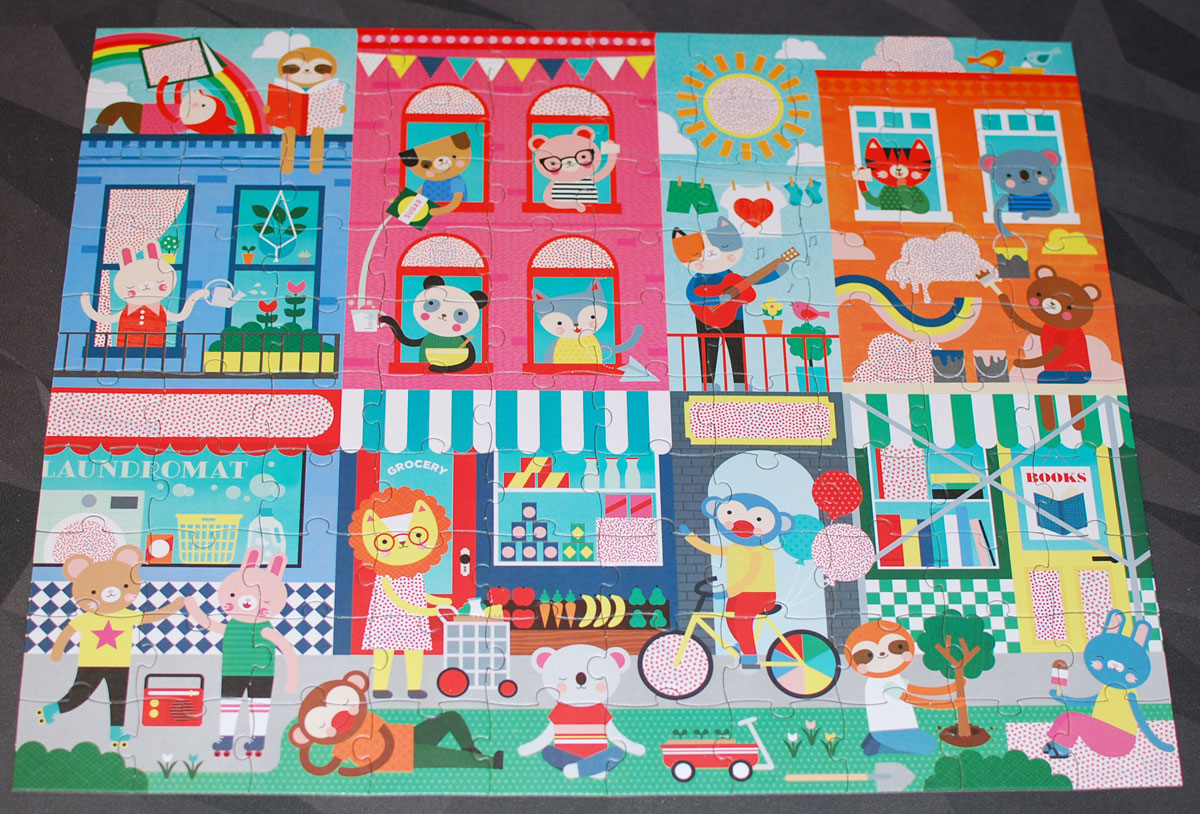
Friendly Neighborhood Decoder Puzzle
($18.00, Petit Collage, 100 pieces)
Petit Collage has a series of “decoder puzzles,” which have some obscured sections in the image that you “decode” using the red-lensed masks.

They’re aimed at younger kids, since the 100-piece puzzle is pretty easy to assemble, but the masks and hidden symbols add a fun surprise element to it. The red lenses are built into two masks—in this case, shaped like a bear and a panda—and each decoder puzzle has its own masks.

I put this one together with my 9-year-old; she’s a little old for it and it didn’t present much of a challenge, but we still had fun assembling this animal neighborhood and then looking at all the little drawings hidden throughout the puzzle. The image has a few stores and apartment buildings, with cute animals enjoying their day.

Recreational Bears Multi Puzzle
($26.95, Seltzer Goods, 705 pieces)
I wrote about another Seltzer multi puzzle back in the fall, and this one uses the same concept: there are four different sizes of pieces included, so that one side of the puzzle uses the really large pieces, and they get progressively smaller as you work your way across. It makes for a nice family activity if you have folks with different levels of ability (or patience), because everyone can work with different size pieces for the amount of challenge they like.
This one, illustrated by Yifan Wu, depicts bears out in the forest, climbing trees, hang gliding, fishing, hiking, and more. I really loved the illustration, but the smaller pieces (which I started with) were at the top of the puzzle, which meant I spent a lot of time assembling a large swath of mostly beige sky with a couple of white clouds, while my wife and kids started at the bottom and got to put together a lot of bears and water and rocks, so I was a little envious of them.

Dog Day Out! Puzzle
($16.99, Laurence King, 180 pieces)
Similar to the Seltzer multi puzzle, this one also has different sized pieces, though in this case they come in just two sizes. There are 48 large pieces and 132 small pieces, with the left side of the puzzle using the large pieces.
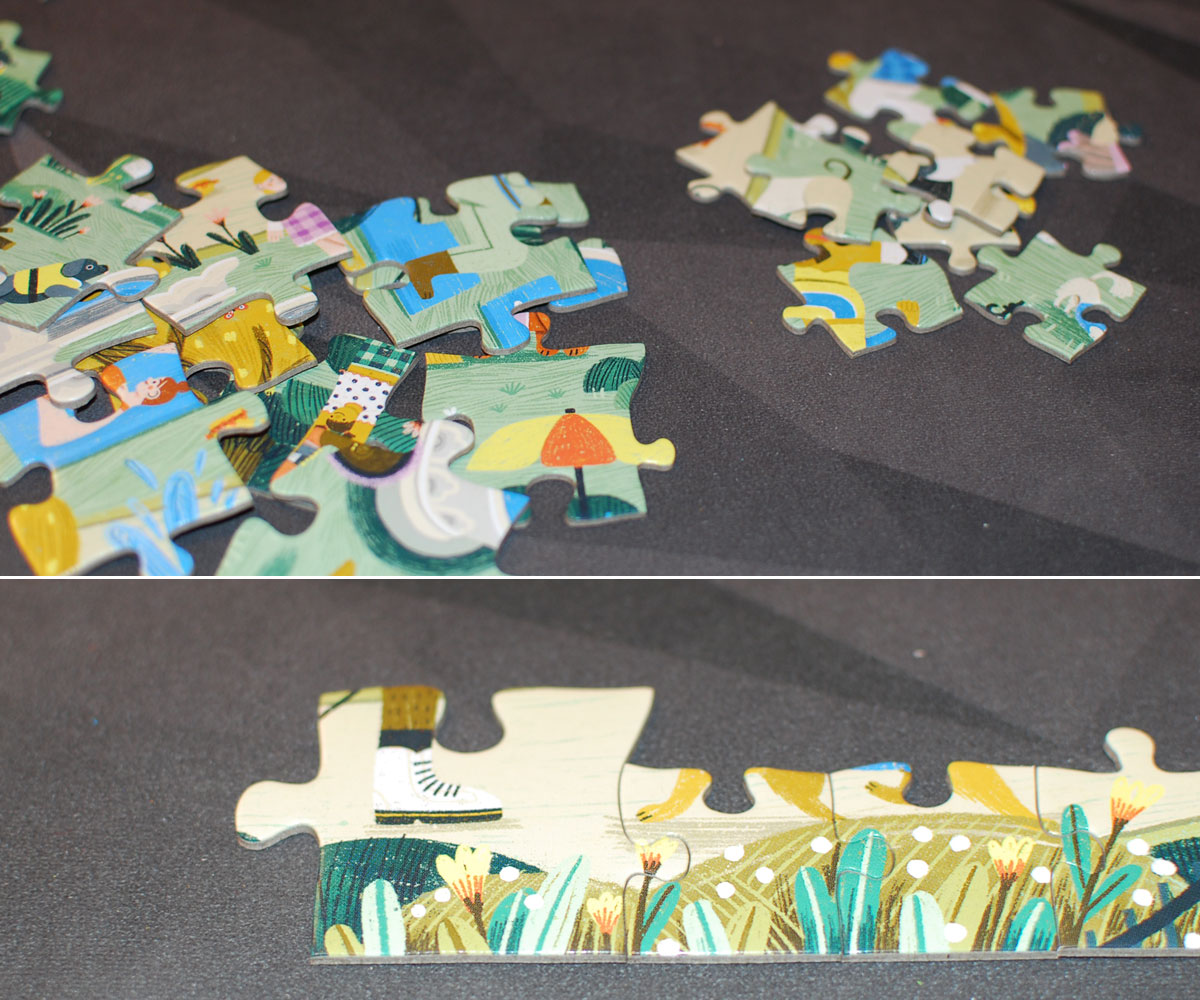
My youngest daughter and I worked on this one together and it was small enough to complete in one sitting. (I think it took us under an hour.) The image depicts a bunch of dogs and their owners at a dog park, with plenty of amusing pet-owner similarities throughout the park.
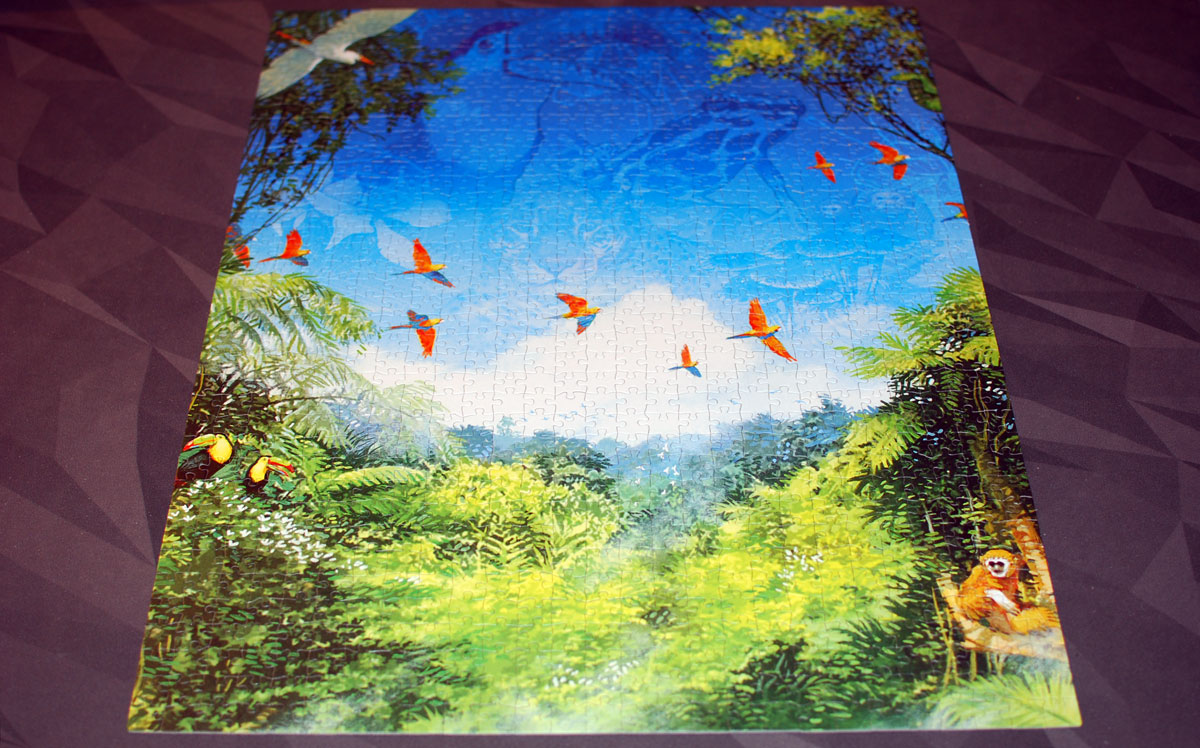
Canopy Puzzle
($22.00, Weird City Games, 1000 pieces)
This beautiful illustration of a rainforest by Vincent Dutrait is actually the cover of a board game, Canopy. The game publisher loved it so much, they decided it would be great to have as a jigsaw puzzle—and I agree! The game box itself is quite small, so I loved getting a much closer look at all of the details in the assembled puzzle.

My oldest daughter and I did most of the work on this one, and it was quite challenging. There are some spots of color that were easy to pick out at first—the macaws flying across the sky, the two toucans perched on the left, and the monkey hanging out on the right. Beyond that, there was a whole lot of sky and a whole lot of greenery. The white cloud section doesn’t look that big on the cover, but when I was assembling it, it felt like it went on forever! We got really good at looking for subtle differences in shades of green, or the gradation of the blue sky. The various images floating in the sky made for some nice variety so it wasn’t all a solid color, too.
After working on this one, I’m inclined to try some other board game puzzles, and I know there are more game publishers who also have puzzles either based on board game covers or inspired by the games. Stonemaier Games just announced a line of Wingspan puzzles recently that looks like fun, and I know Renegade Games also has a line of puzzles based on their game covers and other properties.
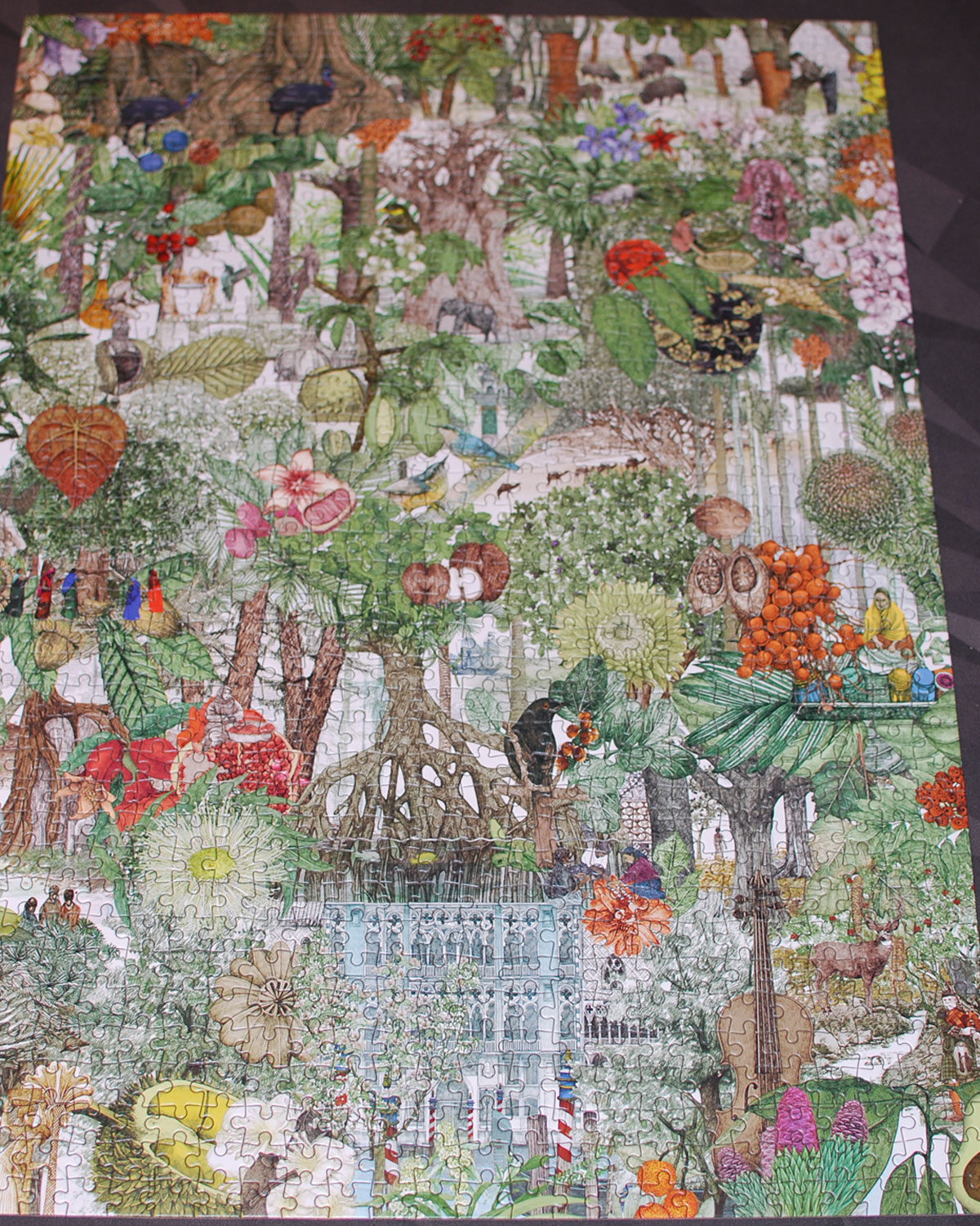
Around the World in 50 Trees Puzzle
($19.99, Laurence King, 1000 pieces)
Another puzzle with a lot of greenery, this one is illustrated by Lucille Clerc, and is a companion to a book by Jonathan Drori with a similar title, Around the World in 80 Trees. (I guess they had to drop 30 of the trees for the puzzle?) The image is a collage of various trees, along with their flowers, fruits, and the ways that the plants have been used.
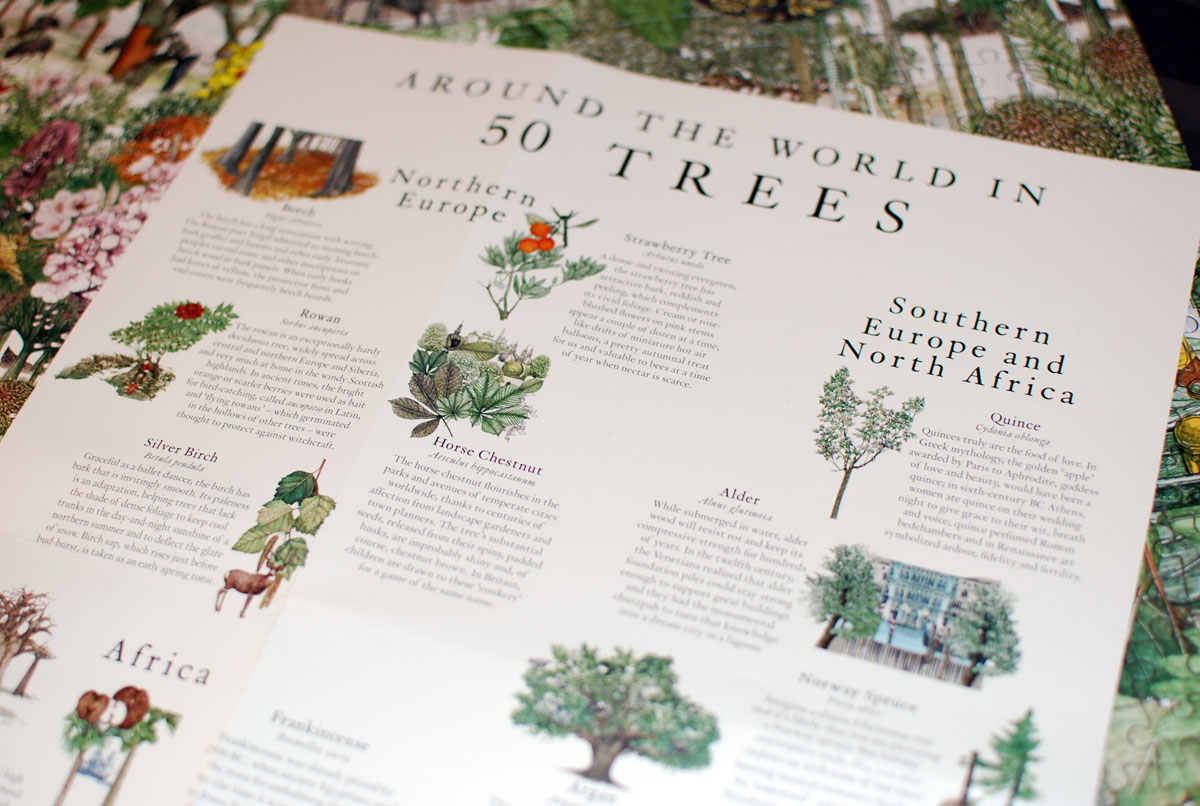
There’s a large fold-out poster that includes not only the puzzle image itself, but also the individual illustration of each tree along with a description, taken from the book. My daughter and I learned about sandbox with its exploding seed pods, which then led us down a YouTube rabbit hole of other exploding seed pods. I was also fascinated by the strange shape of the coco-de-mer seeds, which can weigh up to 65 pounds!
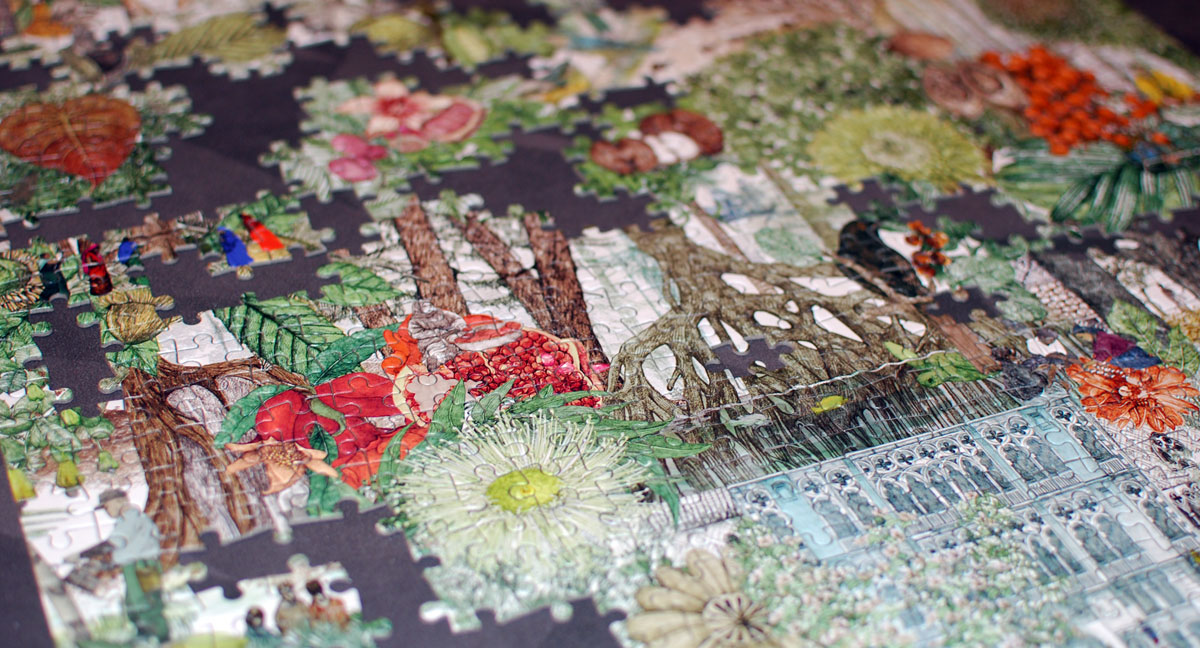
This one was also a challenge because of all of the green leaves, though there were a lot of other bursts of color, especially reds, that helped isolate sections of the picture. I got pretty good at identifying a piece based on the resolution of the green scribbly bits, if I do say so myself.

Woodcut: Three Puzzles
($29.95, Princeton Architectural Press, 300 pieces each)
And here’s one more puzzle about trees—this time, cross sections of trees! This box comes with three 300-piece puzzles, each a print of a woodcut by Brian Nash Gill. Each one is in black and white and provides a gorgeous look at the rings and cracks and bark. The puzzles have slightly different colored backs, so you can separate them out into three individual puzzles, or you can mix them all together for an extra challenge. (I did them one at a time.)

I really love the way these look. The assembly wasn’t too hard per puzzle, though the blank white sections were a little more tedious. I enjoyed trying to line up the curves and lines of the wood grain, and they’re striking when completed.
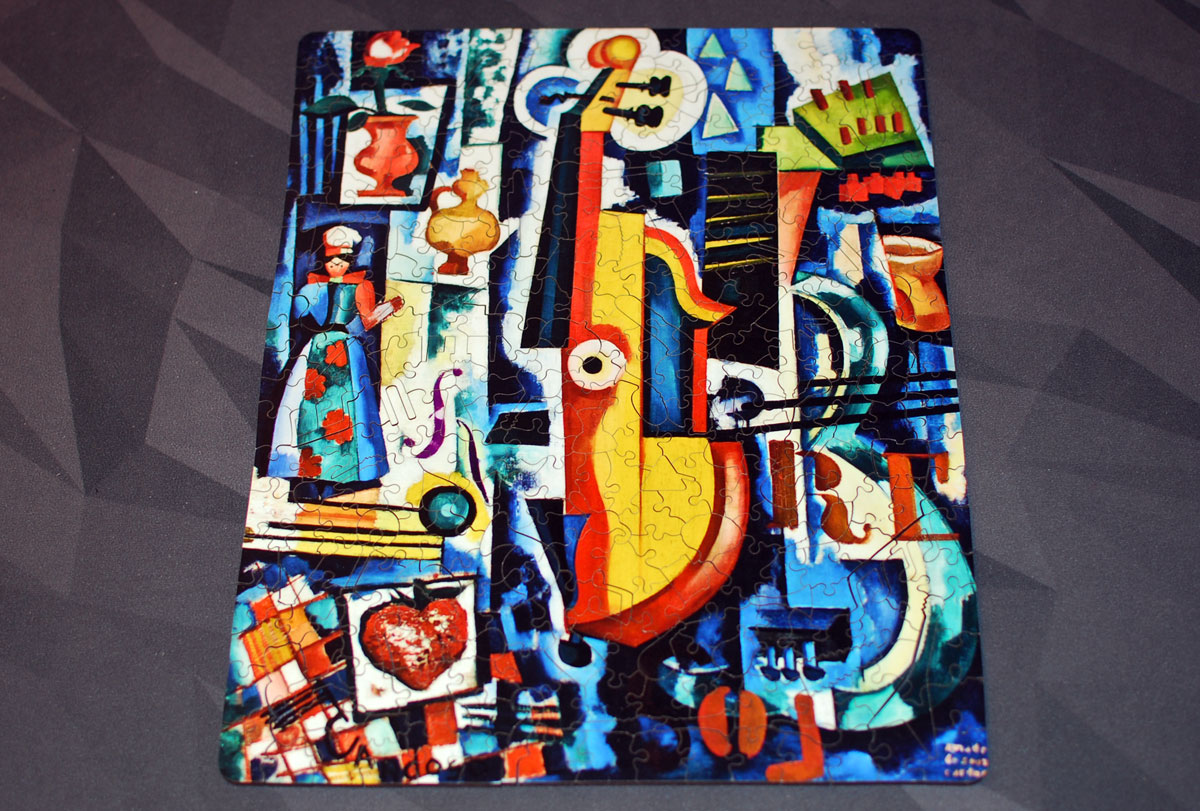
Birth of the Viola Puzzle
($79.95, Nautilus Wooden Puzzles, 349 pieces)
So far, all of the puzzles I’ve worked on have been more standard cardboard puzzles, but this one stands out because it’s a wooden puzzle with laser-cut pieces. Nautilus Wooden Puzzles has a wide selection of puzzles that come in three difficulty levels and range in price based on how many pieces there are. They offered me a couple of choices, and I decided to try this one, Birth of the Viola by Amadeo de Souza Cardoso, because I play the viola myself. It’s a Level 2 difficulty.
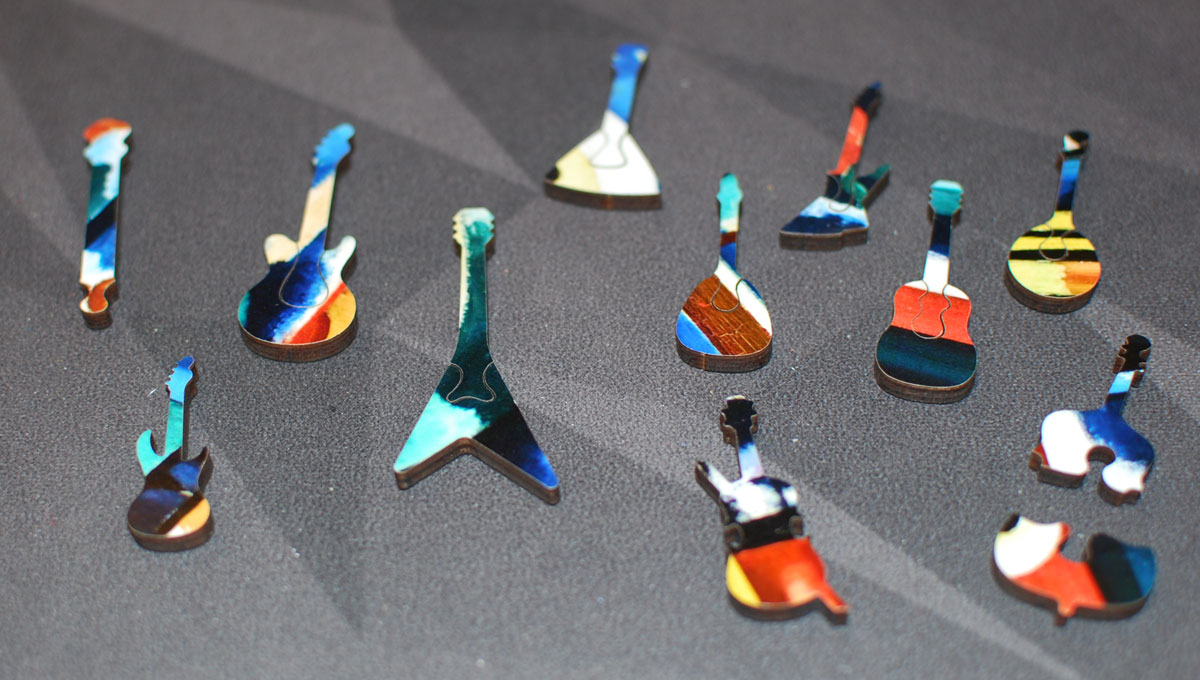
The pieces don’t have the traditional puzzle piece shape, but instead are quite varied. Each of Nautilus’ puzzles has special shaped pieces that fit the theme: in this case, there are a whole lot of musical instruments included. That was a really fun element. In some cases, the instrument was a single piece, and in others they were two or three pieces that had to be assembled. There were several stringed instruments with long necks, and those mean that there were a lot of interior pieces that had straight edges, impersonating border pieces. It also meant that not all of the pieces interlock with each other, so at times you had to build all the way around an instrument before it was really locked in.
I had a lot of fun putting this one together, both for the unique shapes and the abstract painting of the viola, which made for a visually interesting assembly. The pieces have a little more give so the whole thing can feel a little more wobbly than a cardboard puzzle, but the thickness does keep them from falling apart once you have pieces that interlock. My two older daughters felt like they didn’t get to do quite as much of this one when I worked on it (it was hard to quit!), so they ended up taking it later and assembling it again together.
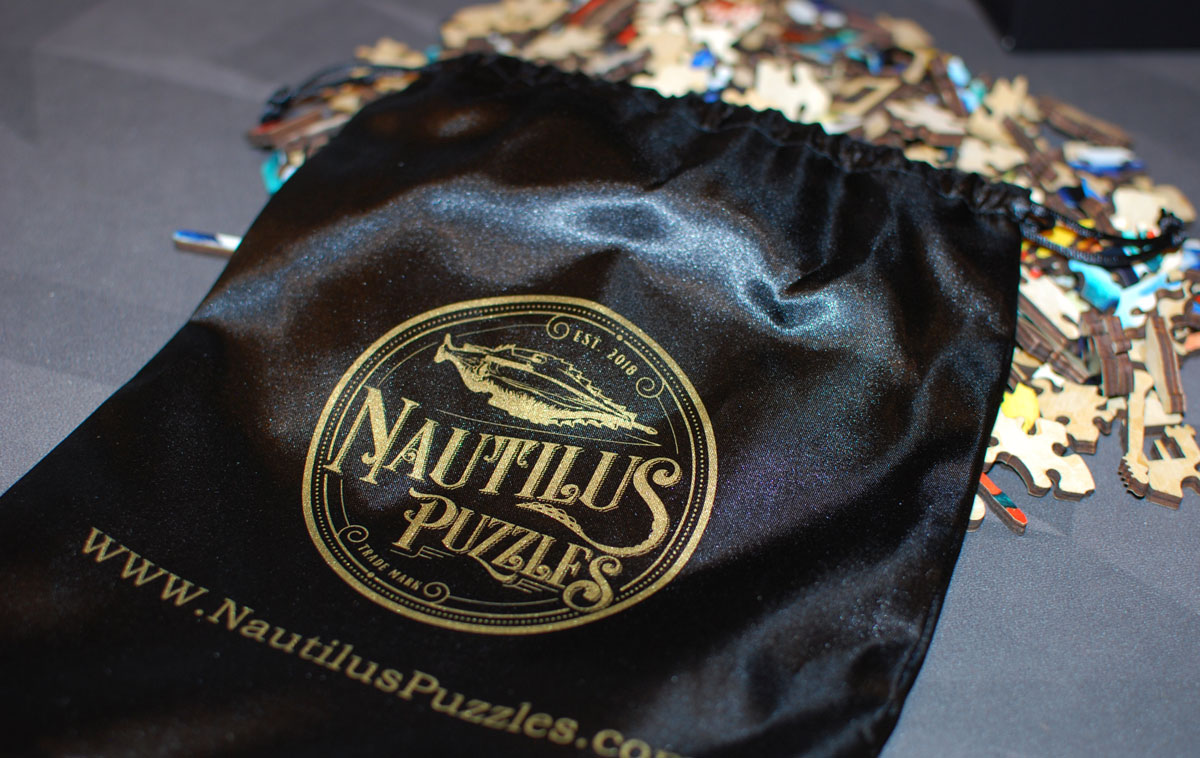
The Nautilus puzzles do come at a higher price and are more of a luxury item; there’s a nice box with a magnetic flap, and a fabric drawstring bag inside for the pieces as well. Having done one, I do think I’d enjoy trying some more puzzles of this type in the future—maybe even a Level 3 difficulty! Paul Benson recently wrote about another wooden puzzle company, Bewilderness puzzles, that has a couple of different types of pieces as well.

Beyond the Kelp Puzzle
($35.00, Odd Pieces, 1000 pieces)
I mentioned Odd Pieces when they were on Kickstarter last year, and I ended up backing the project myself for a puzzle, and a friend of mine also gave me this one as a gift for Christmas. The idea behind the Odd Pieces puzzles is that the image on the cover (and the included poster) does not exactly match the puzzle itself. Each puzzle has a story, explained in a mini comic, and when you finish the puzzle you get to see what happens next in the scene. There’s also a little checklist to tell you some details to look for. Finally, there’s a secret envelope to open once you’ve completed the puzzle that includes another mini comic telling the rest of the story, as well as a postcard of the final image. (I didn’t include a photo of the completed puzzle to avoid spoilers.)
Beyond the Kelp, illustrated by Juanpablo Castromora, depicts an undersea world filled with various sea creature people (maybe sea monkeys?). There are folks engaged in various activities—reading, at a music class, riding an eel train—but most of them don’t seem very happy. The completed puzzle shows them achieving their goals and finding joy.
It’s a neat concept, and the fact that the finished image doesn’t quite match the cover means that you can’t simply look at a piece and compare it to the cover to see where it goes, because at times there are features that simply didn’t appear at all in the sample image, or else are in a different place altogether. I really enjoyed the challenge of putting together a puzzle where you didn’t know exactly what it would look like when you finished, and the undersea scene was very fun. The one I backed was the Turbo 3000 puzzle, so I’m looking forward to working on that one soon!

Character Mini Puzzle
($21.00 for 3-pack, Odd Pieces, 150 pieces each)
As part of the Kickstarter, I also got one of these character mini puzzles, which are now available in 3-packs from Odd Pieces. Although it has more pieces than the LEGO Minifigure puzzle, it’s smaller, because the pieces themselves are tiny! They come in little test-tube-shaped bottles and feature characters from the three puzzle illustrations, so mine was the Turbo 3000 characters. It was like a puzzle snack, a quick assembly that didn’t take up too much space on the dining table. The only thing was that with the pieces being so tiny, it was sometimes more difficult to tell whether two pieces actually interlocked properly, particular in the background areas.

In the Bookstore Puzzle
($16.95, Princeton Architectural Press, 1000 pieces)
You know me: I love books, and I love wandering around in bookstores, just taking in everything on the shelves. So this puzzle had a special appeal to me: it’s a 5-story bookstore, and each section of the store has a sign indicating its genre and is filled with references to that genre. You’ll find Charlie Brown and Little Nemo in the Graphic Novels section, while the sports section has a half-pipe for skateboarders and two people fencing.

Each section’s books are in a single color, which helped a little for grouping pieces, though some of the colors are used more than once so that gets a little tricky, too. I did think the grey Young Adult section with a bunch of teenagers on their phones was a bit of a cheap shot, considering how successful Young Adult books are, but overall it was a really fun illustration.

The Office Building Talking Jigsaw Puzzle
(Buffalo Games, 560 pieces)
This last one is an old puzzle that I’ve had lying around for ages. I don’t even remember where we got it—perhaps at a garage sale or a thrift store—but for whatever reason I never got around to putting it together. The idea is that you assemble a bunch of different rooms (each made up of 4 pieces), and these rooms fit together with each other in any configuration, so you have to figure out the solution based on conversations that the various characters are having with each other, as well as other clues seen in the images. In fact, all of the pieces in the entire puzzle (except for the border) are identical, so you have to assemble the entire thing based on image rather than shape.
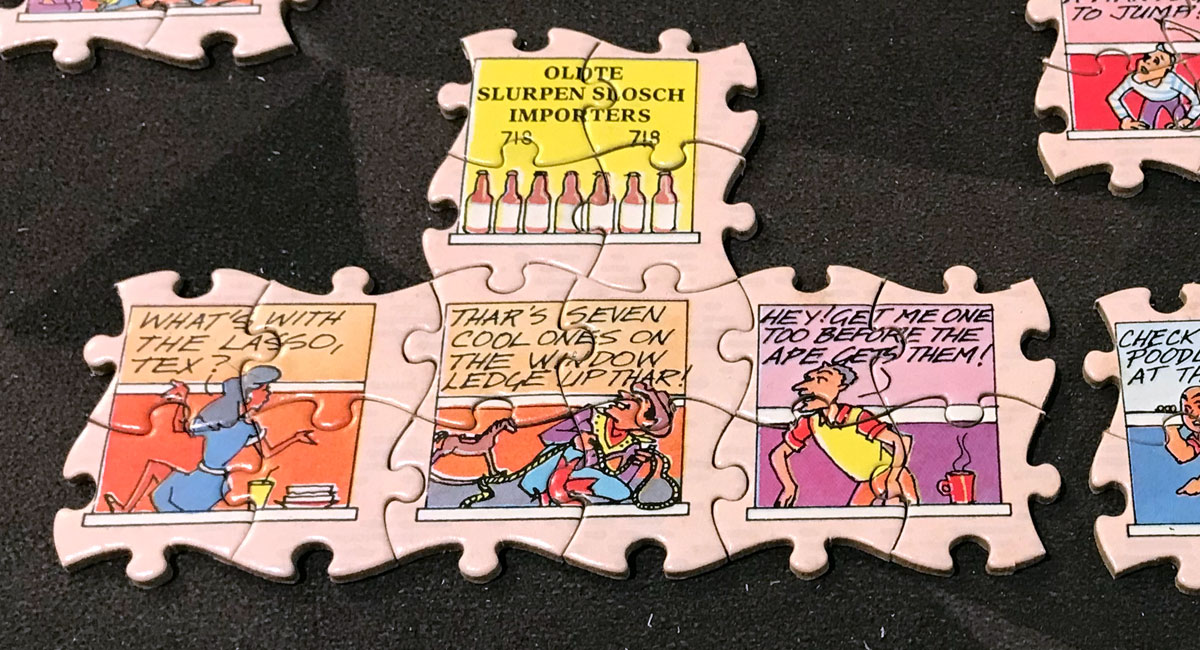
There were apparently five versions of this Talking Jigsaw Puzzle. Mine was the office building, which showed a 9-story building. Various characters were leaning out of the windows talking to each other, or else seen in their offices. There was an escaped gorilla, a big party, a nude sunbather, and a lot more. Assembling the top half of the rooms with speech bubbles and captions wasn’t too difficult, but the bottom half was more of a challenge, because often there various background details that meant that the two halves of the room didn’t appear to have the same background color. Once I got all the rooms put together, though, the real challenge was figuring out the overall layout. This one had some hints like an office directory, or people referring to room numbers next door, or directly above or below them. Once you finish it, you can flip the puzzle over—the back is just the word “Congratulations” printed over and over in different fonts, and if you got the arrangement right, it will all line up. (I don’t show the completed puzzle here, to avoid spoilers.)

One thing I did notice about this puzzle was that the humor felt a bit outdated, particularly because there were a few subplots about men ogling women, whether it was trying to get a look at the sunbather or peeking in the window of a photography studio that used nude models. For that reason, although I enjoyed the challenge of figuring out the puzzle itself, I wasn’t quite as enthusiastic about the finished result. I’d be curious to see if there’s anyone making similar types of logic-based jigsaw puzzles now, particularly something that would be more appropriate for younger kids.
Disclosure: I received review samples of the puzzles in this article, except for the Odd Pieces puzzles and the Talking Jigsaw Puzzle.
My Current Stack
Hope you enjoyed today’s unconventional stack! I’ve been reading some books, too! I got a stack of new and upcoming kids’ comics from First Second, so my daughter and I have been making our way through those. I also re-read The League of Unexceptional Children to my youngest—I’d read it years ago to my older daughters, so it was fun to revisit that, and I ended up picking up the next book in the series because we actually never got around to it the first time around. More on these in future Stack Overflow columns!
Click through to read all of "Stack Overflow: Puzzle Power" at GeekDad.If you value content from GeekDad, please support us via Patreon or use this link to shop at Amazon. Thanks!
